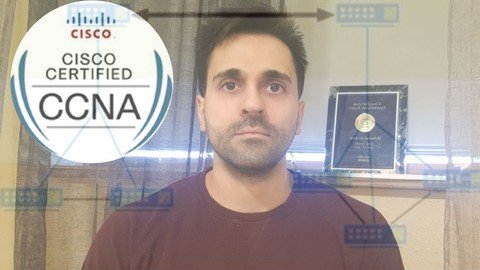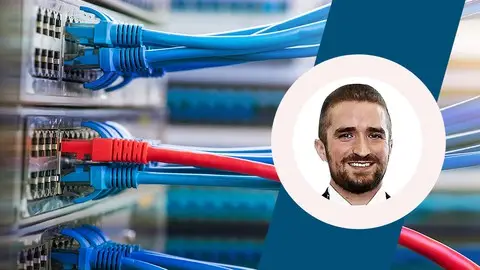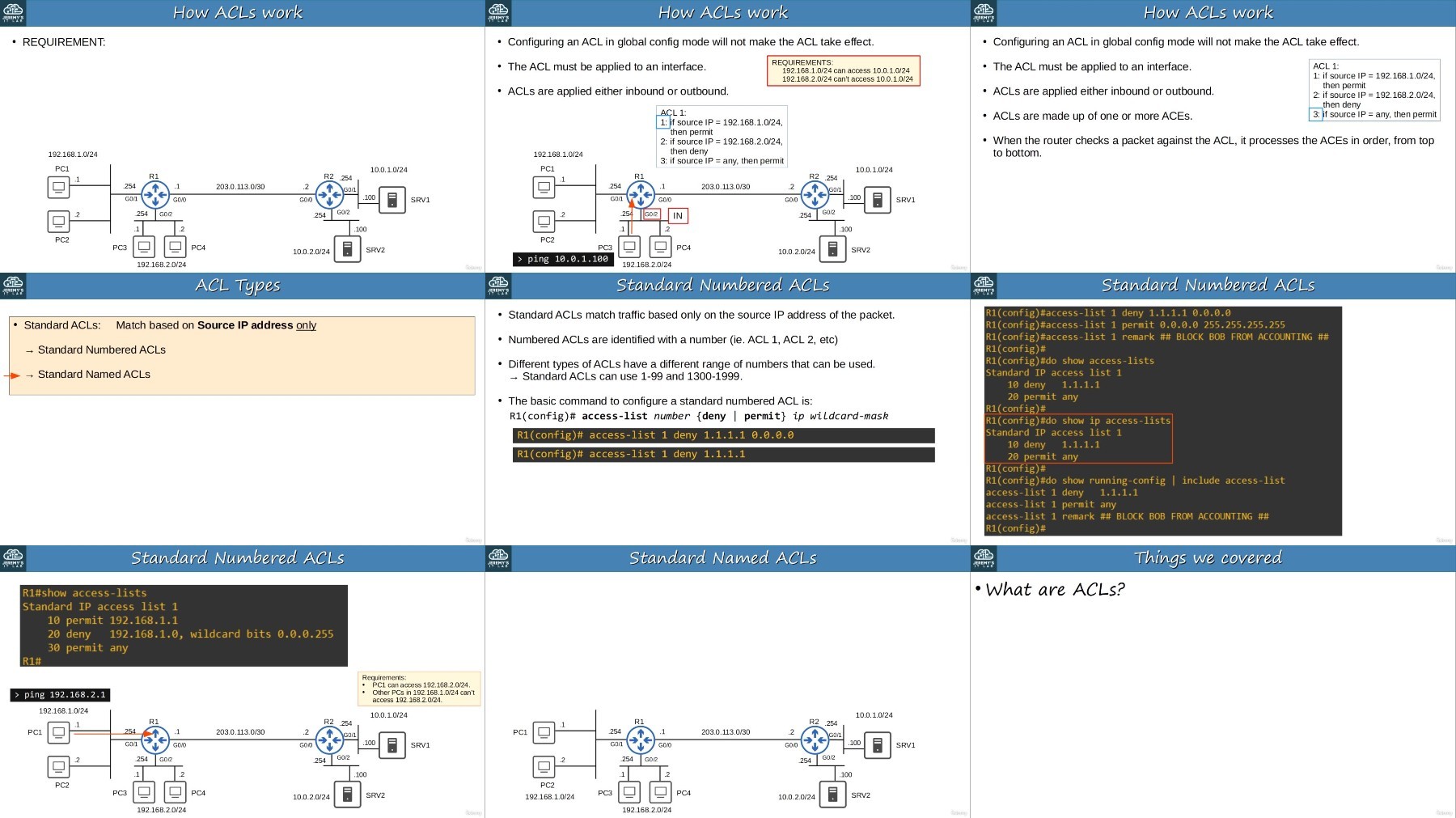
Free Download Cisco Ccna 200 - 301 Complete Course by Mohanad Al-Zaidi
Published 11/2023
MP4 | Video: h264, 1920x1080 | Audio: AAC, 44.1 KHz
Language: English | Size: 28.71 GB | Duration: 23h 30m
Completed course to have full knowledge of CCNA curriculum and to pass the CCNA 200 - 301 exam.
What you'll learn
Get prepared for the CCNA 200-301 exam.
Learn about Network fundamentals.
Learn about Network services.
Learn about network security.
Learn about IPv6 addresses.
Learn about Network security.
Learn about QoS in networks.
Learn about using clouds with networks.
Learn about SDN and virtualization in networks.
Learn about wireless networks.
Requirements
Beginners of network can take this course.
The course takers need to install Cisco packet tracer in their PC (can be downloaded for free).
Other emulation software like GNS3 will be beneficial but not must.
Description
CONTENTS:Chapter 1 InternetworkingInternetworking BasicsSamples of the physical component of the networkInternetworking Models (OSI Reference Model)Review 1Chapter 2 Ethernet Networking and Data EncapsulationEthernet NetworksEthernet CablingData EncapsulationThe Cisco Three-Layer Hierarchical Model (Three-tier architecture)2-Tier Spine Leaf ArchitectureReview 2Chapter 3 Introduction to TCP/IPIntroducing TCP/IPIP AddressingReview 3Chapter 4 Subnetting and VLSMsSubnetting BasicsVariable Length Subnet Masks (VLSMs)SummarizationTroubleshooting IP AddressingReview 4Chapter 5 Cisco's Internetworking Operating System (IOS)The IOS User Interface & Command-Line Interface (CLI)Administrative ConfigurationsRouter and Switch InterfacesViewing, Saving, and Erasing ConfigurationsReview 5Chapter 6 Managing a Cisco InternetworkThe Internal Components of a Cisco Router and SwitchBacking Up and Restoring the Cisco ConfigurationConfiguring DHCPSyslogNetwork Time Protocol (NTP)Exploring Connected Devices Using CDP and LLDPUsing TelnetResolving HostnamesChecking Network Connectivity and TroubleshootingReview 6Chapter 7 Managing Cisco DevicesManaging the Configuration RegisterBacking Up and Restoring the Cisco IOSReview 7Chapter 8 IP RoutingRouting BasicsThe IP Routing ProcessConfiguring IP RoutingConfiguring IP Routing in Our NetworkRouting Information Protocol (RIP)Review 8Chapter 9 Layer 2 SwitchingSwitching ServicesConfiguring Catalyst SwitchesReview 9Chapter 10 VLANs and Inter-VLAN RoutingVLAN BasicsIdentifying VLANsRouting between VLANsConfiguring VLANsReview 10Chapter 11 SecurityTrusted & Untrusted networks termsIntroduction to Access ListsStandard Access ListsExtended Access ListsMonitoring Access ListsNGFW Firewall, IDS, IPS, ESA, and WSAReview 11Chapter 12 Network Address Translation (NAT)When Do We Use NAT?Types of Network Address TranslationNAT NamesHow NAT WorksTesting and Troubleshooting NATReview 12Chapter 13 Internet Protocol Version 6 (IPv6)Why Do We Need IPv6? / The Benefits and Uses of IPv6IPv6 Addressing and ExpressionsHow IPv6 Works in an InternetworkIPv6 Routing ProtocolsConfiguring IPv6 on Our InternetworkConfiguring Routing on Our InternetworkReview 13Chapter 14 Enhanced Switched TechnologiesVLAN Trunking Protocol (VTP)Spanning Tree Protocol (STP)Types of Spanning-tree ProtocolsModifying and Verifying the Bridge IDSpanning-Tree Failure ConsequencesPortFast and BPDU GuardEtherChannelReview 14Chapter 15 Network Device Management and SecurityMitigating Threats at the Access LayerExternal Authentication OptionsSNMPIntroducing First Hop Redundancy Protocols (FHRPs)Hot Standby Router Protocol (HSRP)Review 15Chapter 16 Enhanced IGRPEIGRP Features and OperationsConfiguring EIGRPVerifying and Troubleshooting EIGRPEIGRPv6Review 16Chapter 17 Open Shortest Path First (OSPF)Open Shortest Path First (OSPF) BasicsConfiguring OSPFVerifying OSPF ConfigurationManipulating the election of DR/BDROSPF ScalabilityBasic Multi-area ConfigurationVerifying and Troubleshooting Multi-area OSPFOSPFv3Review 17Chapter 18 Troubleshooting IP, IPv6, and VLANsTroubleshooting IP Network ConnectivityTroubleshooting IPv6 Network ConnectivityChapter 19 Wide Area NetworksIntroduction to Wide Area NetworksCabling the Serial Wide Area NetworkHigh-Level Data-Link Control (HDLC) ProtocolPoint-to-Point Protocol (PPP)Virtual Private NetworksGRE TunnelsBGPReview 19Chapter 20 Quality of Service (QoS)Quality of Service IntroductionTrust BoundaryIOS tools for Classification and MarkingCongestion Management (Queuing)Congestion Avoidance through Drop Policy methods (mostly dropping TCP messages)Policing and Shaping of the trafficQoS configuration in IOSReview 20Chapter 21 Evolution of Intelligent NetworksSwitch StackingIntroduction to the Cloud computingCloud computing characteristicsCloud computing Deployment modelsCloud computing service modelsVirtualizationSoftware Defined InfrastructureCisco SD-AccessCisco SD-WANNetwork Automation and Programmability IntroductionInteraction with Cisco IOS XE API - Device ProgrammabilityReview 21Chapter 22 Wireless Networking FundamentalsWireless Network TypesWireless Network modesWireless Infrastructure architecturesAP modesWiFi spectrum and its channelsCisco Wireless LAN Controller (WLC) ports and interfacesWireless Lab DemoReview 22
Overview
Section 1: Introduction, the pdf file for the entire course, and the Cisco packet tracer
Lecture 1 Introduction
Section 2: Introduction to networks and IP addresses
Lecture 2 Chapter 1: Internetworking
Lecture 3 Chapter 2: Ethernet Networking and Data Encapsulation
Lecture 4 Chapter 3: Introduction to TCP/IP
Lecture 5 Chapter 4: Subnetting and VLSMs
Lecture 6 Chapter 4 Questions
Section 3: Network devices configuration
Lecture 7 Chapter 5: Cisco's Internetworking Operating System (IOS)
Lecture 8 Chapter 6: Managing a Cisco Internetwork
Lecture 9 Chapter 7: Managing Cisco Devices
Section 4: Introduction to routing and switching
Lecture 10 Chapter 8: IP Routing
Lecture 11 Chapter 9: Layer 2 Switching
Lecture 12 Chapter 10: VLANs and Inter-VLAN Routing
Section 5: Network security, NAT, IPv6 addresses
Lecture 13 Chapter 11: Security
Lecture 14 Chapter 12: Network Address Translation (NAT)
Lecture 15 Chapter 13: Internet Protocol Version 6 (IPv6)
Section 6: Enhanced network devices Management, Security, and Switching.
Lecture 16 Chapter 14: Enhanced Switched Technologies
Lecture 17 Chapter 15: Network Device Management and Security
Section 7: Routing (EIGRP, OSPF, and troubleshooting)
Lecture 18 Chapter 16: Enhanced IGRP
Lecture 19 Chapter 17: Open Shortest Path First (OSPF)
Lecture 20 Chapter 18: Troubleshooting IP, IPv6, and VLANs
Section 8: WAN, and QoS
Lecture 21 Chapter 19: Wide Area Networks
Lecture 22 Chapter 20: Quality of Service (QoS)
Section 9: Evolution of Intelligent Networks
Lecture 23 Chapter 21: Evolution of Intelligent Networks
Lecture 24 Chapter 21 questions
Section 10: Wireless Networking Fundamentals
Lecture 25 Chapter 22: Wireless Networking Fundamentals
Lecture 26 Chapter 22 questions
Section 11: General review Lab
Lecture 27 General review Lab
Beginners of network.
Homepage
Recommend Download Link Hight Speed | Please Say Thanks Keep Topic Live
No Password - Links are Interchangeable









